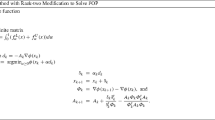A class of splitting iterative methods is considered for solving fuzzy system of linear equations, which cover Jacobi, Gauss–Seidel, SOR, SSOR, and their block variants proposed by others before. We give a convergence theorem for a regular splitting, where the corresponding iterative methods converge to the strong fuzzy solution for any initial vector and fuzzy right-hand vector. Two schemes of splitting are given to illustrate the theorem. Numerical experiments further show the efficiency of the splitting iterative methods.
Similar content being viewed by others
References
S. Abbasbandy, R. Ezzati, and A. Jafarian, “LU decomposition method for solving fuzzy system of linear equations,” Appl. Math. Comput., 172, 633–643 (2006).
S. Abbasbandy and A. Jafarian, “Steepest descent method for system of fuzzy linear equations,” Appl. Math. Comput., 175, 823–833 (2006).
S. Abbasbandy, A. Jafarian, and R. Ezzati, “Conjugate gradient method for fuzzy symmetric positive-definite system of linear equations,” Appl. Math. Comput., 171, 1184–1191 (2005).
T. Allahviranloo, “Numerical methods for fuzzy system of linear equations,” Appl. Math. Comput., 155, 493–502 (2004).
T. Allahviranloo, “Successive overrelaxation iterative method for fuzzy system of linear equations,” Appl. Math. Comput., 162, 189–196 (2005).
B. Asady, S. Abbasbandy, and M. Alavi, “Fuzzy general linear systems,” Appl. Math. Comput., 169, 34–40 (2005) .
Z.-Z. Bai, G.H. Golub, L.-Z. Lu, and J.-F. Yin, “Block triangular and skew-Hermitian splitting methods for positive-definite linear systems,” SIAM J. Sci. Comput., 26, 844–863 (2005).
Z.-Z. Bai, G.H. Golub, and M. K. Ng, “Hermitian and skew-Hermitian splitting methods for non-Hermitian positive-definite linear systems,” SIAM J. Matrix Anal. Appl., 24, 603–626 (2003) .
Z.-Z. Bai, G.H. Golub, and J.-Y. Pan, “Preconditioned Hermitian and skew-Hermitian splitting methods for non-Hermitian positive semidefinite linear systems,” Numer. Math., 98, 1–32 (2004).
J.J. Buckley, “Solving fuzzy equations in economics and finance,” Fuzzy Sets and Systems, 48, 289–296 (1992).
S. L. Chang and L. A. Zadeh, “On fuzzy mapping and control,” IEEE Trans., Syst. Man Cyb., 2, 30–34 (1972).
M. Friedman, M. Ming, and A. Kandel, “Fuzzy linear systems,” Fuzzy Sets and Systems, 96, 201–209 (1998).
H. Minc, Nonnegative Matrices, Wiley, New York (1988).
S. S. Rao and L. Chen, “Numerical solution of fuzzy linear equations in engineering analysis,” Int. J. Numer. Methods Eng., 42, 829–846 (1998).
R. S. Varga, Matrix Iterative Analysis, Prentice-Hall, Englewood Cliffs, NJ (1962).
K.Wang and B. Zheng, “Symmetric successive overrelaxation methods for fuzzy linear systems,” Appl. Math. Comput., 175, 891–901 (2006).
K. Wang and B. Zheng, “Block iterative methods for fuzzy linear systems,” J. Appl. Math. Comput., 25, 119–136 (2007).
L.A. Zadeh, “Fuzzy sets,” Inform. Control, 8, 338–353 (1965).
Author information
Authors and Affiliations
Corresponding author
Rights and permissions
About this article
Cite this article
Yin, JF., Wang, K. Splitting iterative methods for fuzzy system of linear equations. Comput Math Model 20, 326–335 (2009). https://doi.org/10.1007/s10598-009-9039-9
Published:
Issue Date:
DOI: https://doi.org/10.1007/s10598-009-9039-9



